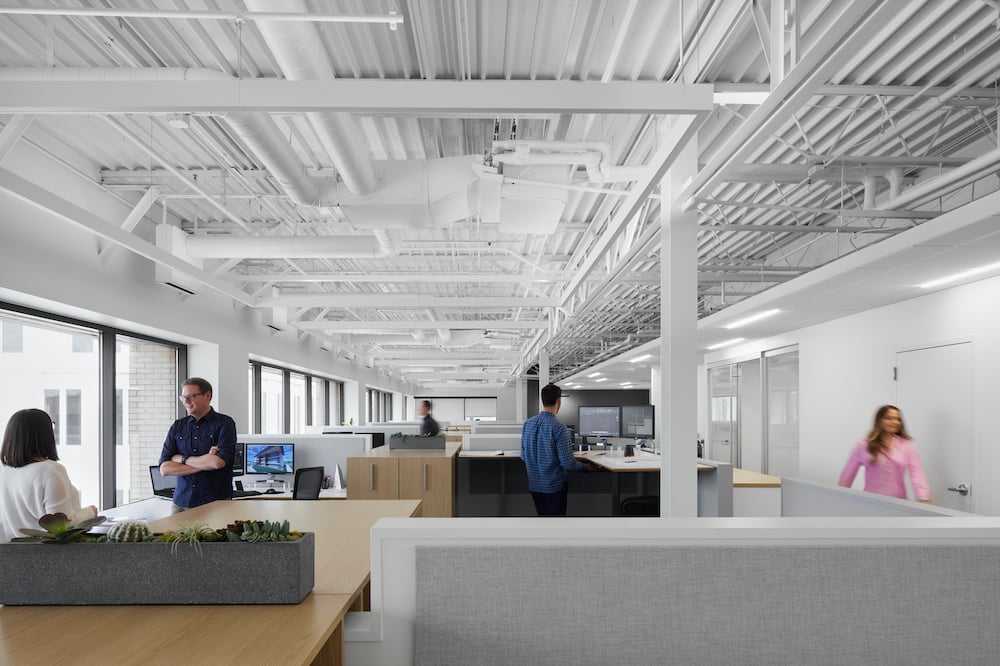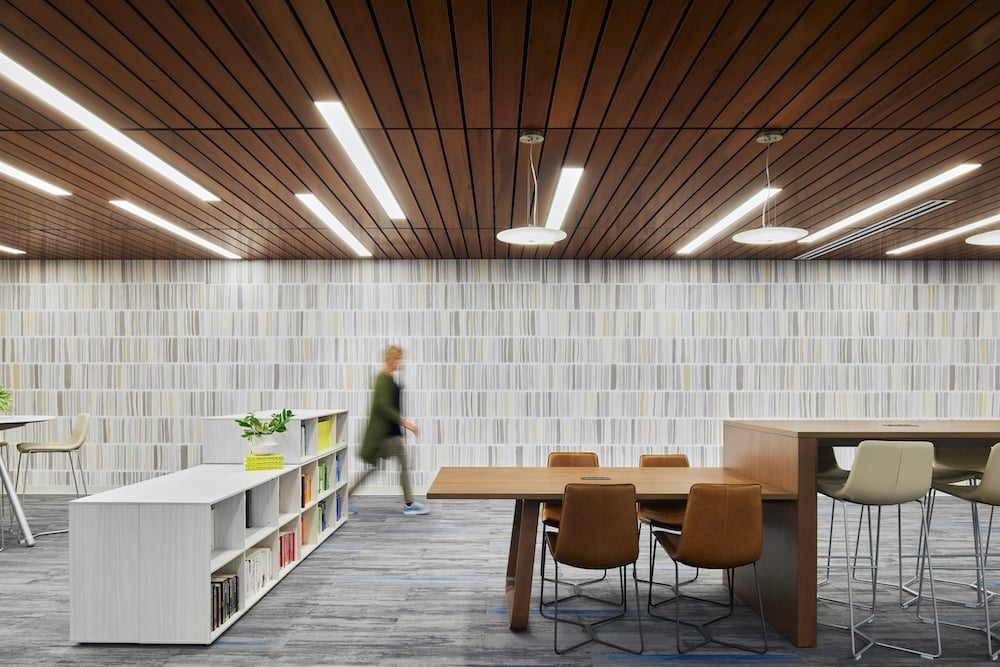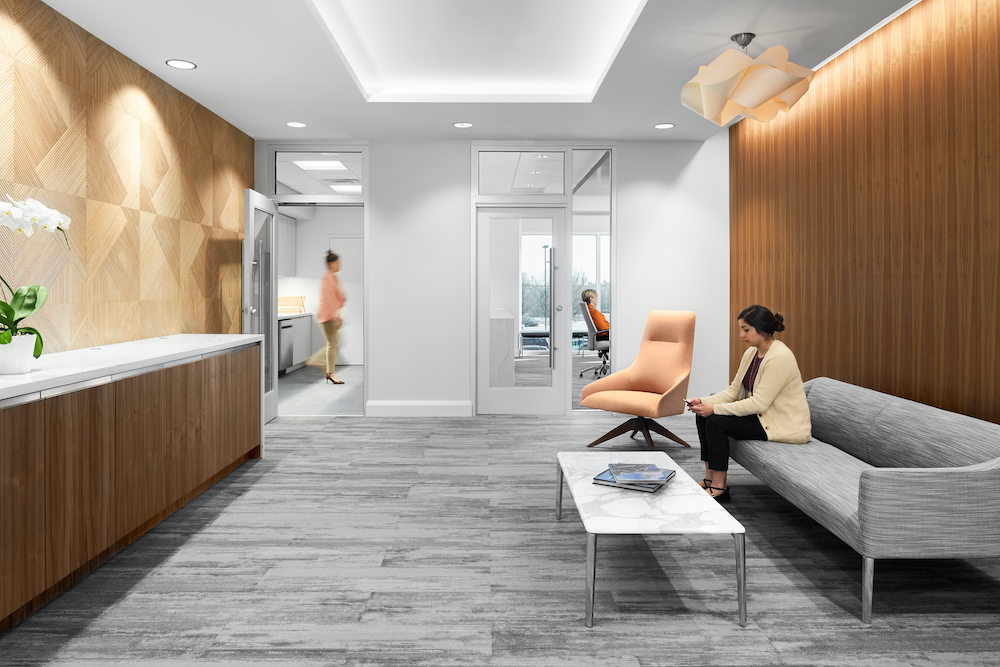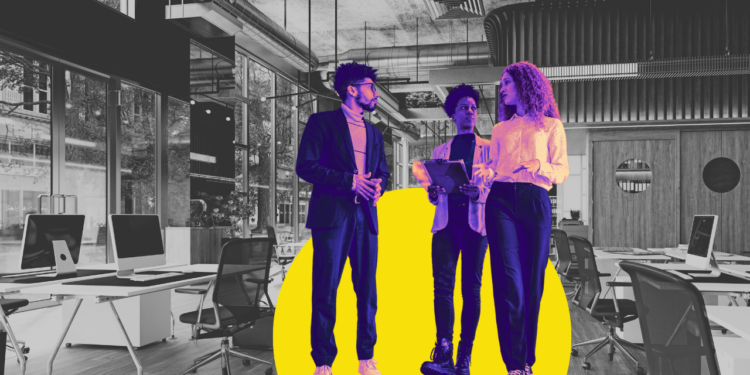- If architecture has the capacity to strengthen our interpersonal relationships, then it can boost our happiness.
- For those of us who are returning to the workplace on a regular basis, being surrounded by an environment that strengthens our connections with other people will undeniably impact our emotional well-being.
- Through simple, actionable strategies such as light, color, space, and layout, designers can create stronger, healthier workplaces.
This article was originally written by Bockus Payne’s Collin Fleck for Work Design Magazine.
Architecture is, at its core, about people. It is about how people engage with the built environment and, by extension, with each other. Moreover, happiness derives primarily from human relationships. Therefore, if architecture has the capacity to strengthen our interpersonal relationships, then it can boost our happiness.
For those of us who are returning to the workplace on a regular basis, being surrounded by an environment that strengthens our connections with other people will undeniably impact our emotional well-being. At a time when mental health is top of mind for us all, we cannot overlook the power of our surroundings to impact our comfort, fulfillment, and overall happiness.
Generating happiness and mental wellbeing at work will depend on how well the physical environment can facilitate these relationships. Through simple, actionable strategies such as light, color, space, and layout, designers can create stronger, healthier workplaces.
In 2021, we relocated the Bockus Payne headquarters into a new, self-designed modern workplace. This process allowed us to experience firsthand as a company how the design of an office can facilitate (or hinder!) interpersonal connection and employee morale. Our team culture has grown exponentially since the move, and so much of this can be traced directly to actionable design strategies that encourage better relationships amongst the staff.

Daylighting, Hierarchy, and Happiness: Everyone Gets an Equal Slice of the Pie
Daylighting: It’s not a new concept, but it’s important. A cursory google search will pull up dozens of studies proving that access to daylight makes people feel better—and yet, many workplaces are still relegating receptionists and junior staff into gloomy cubicles under harsh fluorescent lighting, while reserving the bright and airy corner spaces for partners and executives.
The organizing principle of any modern workplace should be an effort to maximize daylighting and ensure that everyone—regardless of rank—gets an equal slice of the daylight pie. This is a great way to encourage companies to focus less on hierarchy. Workplace designers should always be thinking about the receptionist or the intern. How are they accessing daylight? The new Bockus Payne HQ celebrates daylight, and our staff is visibly happier. People walk in and immediately greet one another. It is simply easier to start your day right in a brightly lit space that facilitates interaction.

Space and Color: Encouraging Warmth and Positivity
Along with light, space is crucial in designing a healthy workplace. Principles of light and space actually go back as far as gothic architecture, and much like in the cathedrals of old, we try to find impactful ways to create volume in our designs. Bringing additional volume and height into social spaces in particular helps uplift people and naturally encourages kinder and more productive interactions.
The use of color can be debated within the design field but sticking with neutral walls allows people to make the space their own through furnishings, artwork, and even their wardrobe. In this sense, architecture becomes more of a canvas on which to represent company culture.
Neutral colors are also calming, whereas overly vibrant tones like red can increase irritation. On the opposite side of the pendulum, if you take too much color out of a space, you risk stripping its warmth and ending up with a cold, sterile environment. Incorporating wood tones and interior plants is a great way to maintain warmth, even against neutral backdrops. It’s all about balance.

Working Styles and Intergenerational Dynamics: It’s All About Comfort
A well-designed workplace will allow all different types of people to feel comfortable and productive. Interestingly, each generation seems to gravitate towards a different style of working. The incoming generation seems to want the polar opposite of the most senior generation, and we’re just beginning to scratch the surface of figuring out exactly what that is.
As designers, we need to ask ourselves: What makes the next generation comfortable in a space? How do we minimize discomfort through design? The differences are stark when you look at where different groups of people gravitate towards when setting up a meeting. Some naturally seek open tables in communal cafes, while others prefer closed-off, private conference rooms. The role of the architect is to provide a variety for all work styles that allows people to find a space where they feel comfortable.
In Bockus Payne’s former office, each desk was separated by high panels, creating an almost claustrophobic feeling. The new office balances separation and a completely open environment, with lower-height panels that make it easier to interact and stay connected while still allowing people to pin up personal items, calendars, and notes.The new office environment is more friendly and vibrant as people are encouraged to communicate with and greet one another.
The past couple of years have laid bare the reason why we go to an office—to interact with and collaborate with our peers, clients, and mentors. As architects and designers, it is our job to create an environment conducive to fostering meaningful interactions, which in turn supports employee happiness and mental wellbeing. Through simple yet effective strategies such as attention to light, volume, and color, we can help establish a healthier, happier, and stronger workforce.


 Dr. Gleb Tsipursky – The Office Whisperer
Dr. Gleb Tsipursky – The Office Whisperer Nirit Cohen – WorkFutures
Nirit Cohen – WorkFutures Angela Howard – Culture Expert
Angela Howard – Culture Expert Drew Jones – Design & Innovation
Drew Jones – Design & Innovation Jonathan Price – CRE & Flex Expert
Jonathan Price – CRE & Flex Expert













